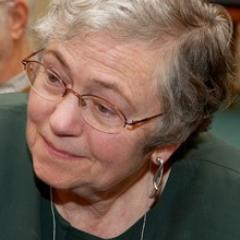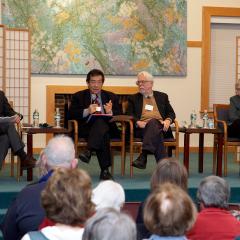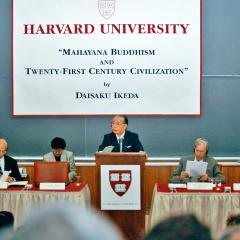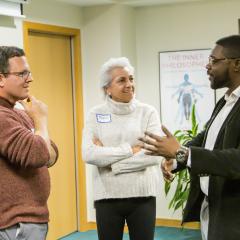Mary Catherine Bateson on What It Means To Compose a Life
Mary Catherine Bateson (1939 - 2021) was a writer and cultural anthropologist. She wrote and co-authored many books and articles, lectured across the country and abroad, and was president of the Institute for Intercultural Studies in New York City. She was the Clarence J. Robinson Professor in Anthropology and English at George Mason University. Her books include Composing a Life, With a Daughter’s Eye, and Willing to Learn: Passages of Personal Discovery. Bateson was interviewed in 2006 by the Center’s Patti Marxsen. Photos by Marilyn Humphries.
Let’s begin with a little background on cultural anthropology, a field many of us associate with the work of your parents, Margaret Mead and Gregory Bateson.
When my parents went into anthropology, anthropologists were almost entirely focused on pre-literate societies that were still fairly isolated. With the spread of imperialism around the world in those days, there was a great sense of urgency about describing the many different ways human beings have lived, ways that have tended to be lost as people accepted the influence of other groups.
Are you suggesting that humans have been gradually conforming in terms of their social organization over the past century?
Yes, we humans have been gradually converging and becoming culturally more similar. My parents met in New Guinea, which is an archipelago with something like 700 languages and lots of different regional groups, each with its own religion, its own traditions, stories, and artistic styles. Over the years people have been converted to religions that come from outside, they do western jobs, they wear trousers and skirts, and many of the old religions have been lost.
When did your mother write her most famous work, Coming of Age in Samoa?
That was in the 1920s. After that, she went to New Guinea. But from the very beginning she looked at research on pre-literate peoples as relevant to our understanding of our own society. When she wrote about Samoa, she wrote about it to advance our understanding of adolescence. Similarly, she believed that looking at childhood in a Stone Age society was relevant to understanding the human condition in general.
That’s a radical idea, that we might learn from “primitive” people, isn’t it?
We still have a lot to learn. One place where you will find that idea expressed a lot today is in the environmental field. People are arguing that indigenous peoples are closer to their environment and more respectful. We could learn a lot from them on that.
You wrote a very successful book titled Composing a Life. There and elsewhere you speak about the composition of lives as an art form. In what way do human lives, especially women’s lives, mirror the process of creative work?
I started writing about American women at a time when women’s lives had changed a great deal and we were trying to do new things, which required creativity. We were trying to combine aspects of life that had previously been regarded as impossible to combine: careers and marriage, careers and family. And most women of my generation could not plan their lives to be like their mothers, so we were trying to do this without models.
This has made our lives more interesting, but has it also made our relationships with our mothers a little more complicated?
Yes, it has. But although that was a very radical shift we went through, it has now become the norm. No one can any longer assume that their lives will be modeled on the life of their same-sex parent, male or female.
Can’t a person choose to “follow in my father’s footsteps”?
Suppose there is this fellow who says, “I am going to be a doctor. My father was a doctor; my grandfather was a doctor; that’s my family tradition.” He thinks he is going to imitate his father, but in fact he cannot be a doctor in the same way as his father or grandfather. He is going to have to deal with managed care and he is going to have to learn all kinds of new technologies. The economics and organization of healthcare has changed radically, not to mention the disease conditions that are being addressed. So, that young man will have a very different career, even though he may be “a doctor like his father.”
No one can any longer assume that their lives will be modeled on the life of their same-sex parent, male or female.
Mary Catherine Bateson
This calls on our creativity.
Yes, the amount of creative problem solving needed in a particular life has increased greatly. My argument in Composing a Life was not just that it takes creativity to put the pieces together and deal with the discontinuities in women’s lives, but that one could regard this process as a creative art form, instead of as a compromise. It’s much better to ask, “How can I put the circumstances of my life and my possibilities and my talents together in a way that will be beautiful and satisfying?”
If women are now more experienced at this, because of the shifts that we went through in the twentieth century, does it hold that we are now more adaptable and creative than men?
I don’t think we are more adaptable or creative than men, but I do think that women are more aware of the need for creative improvisation in their lives than men are because we are so aware of the magnitude of the change we have lived through. And now it’s happening with aging. As we think about aging, we tend to think that old people are like the grandparents we knew, and that is how we are supposed to be.
Yes, that would be logical.
It is logical, but remember that our grandparents grew up in a different world, aged in a different way, had different kinds of medical care, and so, just as women had to figure out how to be women unlike their mothers, people coming up on formal retirement now have to figure out how to be older adults. They will not be like their grandparents, because they are likely to live on for many more active years than their grandparents.
You characterize this post-retirement phase of life as the time for Active Wisdom and you define it as a new developmental stage of life. Tell us more about that.
The big mental shift you have to make is to realize that increased longevity is not an extension of old age. It is a new developmental stage inserted between adulthood and old age anywhere between age 50 and 80, and, for some people, age 90. People go back to school, they form new marriages, they take up new avocations, and they are inventing new ways of growing old. The concept of Active Wisdom, the reason why I use that phrase, is because wisdom is the most positive trait that we associate with old people. In the past, you didn’t have a long life of experience leading to wisdom in combination with many years of continuing energy and health that allow you to be very active.
In this context, are there patterns or common themes in women’s lives, patterns that cut across cultures for women as they age?
I think the commonalities in women’s lives are biological ones. Childbearing, for example, is a common experience, even though different societies elaborate things differently. In America, we live in a society that tends to devalue older people and put a lot of emphasis on youth. So women often feel unattractive and dye their hair and get cosmetic surgery and try to look younger, and increasingly men are doing the same thing. These things have a lot to do with social values. In societies where older people are respected and valued, people make an effort to look older.
Where is that place? I’d like to go there!
This has certainly been true in Japan and in Asian societies in general. Through most of human history, the older members of the community had the most authority, male and female, because their life experience was relevant to the present. But when you bring in rapid cultural change, the effect is to make it harder for older people to keep up and retain their respect and authority.
America, and many industrialized societies, seem to value money and power over wisdom or age.
I think we still have the idea that wisdom matters. If you look at someone like Jimmy Carter, there is a kind of respect that has developed for him that is related to his age and reflectiveness and where he has been and what he has done. But we don’t give people that kind of respect unless they have been keeping up.
He is a good model of wisdom and continual growth. This recognition that people never stop changing and learning is part of what I love about your thinking.
Yes, we keep growing and changing. And one of the great disadvantages of the nuclear family is that you don’t have as much intimate diversity as you would have in an extended family or a close-knit community. So you may not have the opportunity to know people of many different ages as they move through life.
Do you expect to see another global generational rebellion like the one in the sixties? The world is certainly in a very precarious state and there are a lot of things going on that you would expect the youth of the world to reject and want to do better.
I think there will always be idealistic young people, though we could certainly use more at present, and we could talk about why there aren’t as many as there used to be. But I think that particular discontinuity in the 60s may have been a special case.
Let’s talk about idealistic old people. Back to this new developmental stage of Active Wisdom, something you also call Adulthood II to emphasize that it is not “added on” to life expectancy but inserted between retirement and old age. You have written about people in this phase of life as valuable resources. Why is that such a radical idea and why is it more common to look at old people as a burden?
Well, they used to be more dependent in various ways and very old people still are. The concept of institutionalized retirement and pensions was invented for the German Civil Service right around the turn of the twentieth century. The notion was that if someone was 65 or 70 years old, and had worked all his life in the Civil Service, he should not become a beggar. In the United States at that time, life expectancy at birth was 45, and globally it was something like 32. The point is that the number of people who survived on the job to retirement age was fairly small and they didn’t stay on their pensions for very long. Now we have increasing numbers of retired people, but as long as they are healthy the solution is to think in terms of continuing participation and contribution.
Those numbers are astonishing. Things have certainly changed.
Yes, things have changed dramatically. Most people are still alive at 65 and most of them are going to hang around for another 10 years, and a lot of them 15, 20, maybe 30 years. What’s so sacred about age 65? It has been frozen as a symbolic turning point, but this no longer makes sense. We are still telling people that they should retire and take it easy. I think we need to be telling people, “Contribute, do something worthwhile, participate!”
What I see in my retired friends is a lot of very purposeful volunteer work. These are people who have financial security, so they can do that. But it would be interesting to see them getting paid by organizations because they are bringing real skills.
One of the things that needs to be done is to make it easier for retired people to get work that fits their lives.
Should we try to stop thinking in terms of “retirement”? Is that the wrong language?
I think we are going to get increasingly flexible about when and how “retirement” comes. I think we are going to allow various forms of phased retirement and part-time careers for older people, as well as new post-retirement patterns. In our society, we tend to think of work as a burden for a lot of reasons, but life without work can also be a burden.
I am still a little hung up on the word retired. I think it probably comes from the French word retirer, to draw back, as if you want to pull away from the stream of life. But that seems like the wrong image. Maybe “transformation” would be more appropriate.
That’s a good point. But maybe retirement in its original sense continues to make sense but at a much later time. I have met people who say they have retired twice. They have retired from their main career at 60-something and then, after taking up another interest, they finally stop working at 80-something and say, “Well, now I really am going to stop!”
If we could harness all that “active wisdom,” it could change the world.
Why don’t we say “release” and not “harness.” The wisdom is there, but sometimes it is wasted. The assumption that is made about old people by politicians, for example, is that they are only concerned about themselves, their rights, their benefits. If you are helpless and sick and in pain, you are pretty likely to be focused on your own situation, but if you are energetic and in decent health and not impoverished it doesn’t follow that you are self-obsessed.
It might even follow that you have a particular investment or sense of the future.
None of us is going to live forever, but our sense of the future is based on our involvement with young people, especially grandchildren and great-grandchildren. I think people in their eighties care a lot about what the world is going to be like, because they look at their grandchildren and great-grandchildren and they say, “What world will this child live in?”
Much of your writing has been autobiographical and within that category you’ve written with great sensitivity about your famous parents in essays as well as your book, With a Daughter’s Eye: A Memoir of Margaret Mead and Gregory Bateson. Your essay on your father’s death entitled “Six Days of Dying” is particularly moving. In what way was his death a learning experience for you?
One of the things that I feel strongly about is that death is a part of life and simply extending life should not be our primary value. Our value should be on living well, living creatively, instead of just additional time. What we need to do is work hard to give those who are born the possibility of good lives and, in our own way, come to terms with the reality of death and be ready for it eventually.
In Willing to Learn, you pull together a number of essays and articles written over many years. What was it like to bring all of that together?
I was looking over a lifetime’s work, really, with a lot of apparent discontinuity. The connecting threads surprised and interested me, and as I reread things that I wrote many years ago, I found the beginnings of ideas that I am working with now and saw how those interests have played out over time and developed.



